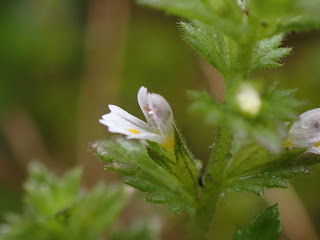 |
| Common Butterwort, Photo by Emily Stone. |
.JPG) |
| Ryan Carlson looks up from his meter-square quadrat where he's counting rare plants on Artist's Point in Grand Marais, MN. Photo by Emily Stone. |
 |
| Hudson's Bay Eyebright. Photo by Emily Stone. |
 |
| Bird's Eye Primrose. Photo by Emily Stone. |
In their book, North Shore: A Natural History of Minnesota's Superior Coast, Anderson and Fischer describe arctic disjuncts as “descendants of botanical pioneers that bear humble witness to a past that lies beyond human memory or record, to the wasting of towering ice sheets, and to the birth of nothing less than the lake itself…”
These plants are tough. They can survive cold, damp conditions, high winds, and a short growing season. What they can’t handle are trees and other plants competing with them for sunlight. So when the climate warmed and new plants moved in, these tundra plants mostly retreated with the ice…except in a few naturally refrigerated habitats like Lake Superior’s shoreline on Artist’s Point. Visitors may curse the summer fog that often envelops Grand Marais, but the plants love it.
 |
| My good friend Miriam (age 7) and I check out a very wet columbine flower on one of those damp, cool days on Artist's Point. Notice that Miriam is in full rain gear! |
These plants are rare here – Common Butterwort is a species of Special Concern in Minnesota and Endangered in Wisconsin – because their habitat is rare. In Iceland, they are common in pastures.
Ryan has gotten to know these plants on a personal level. For three years, he monitored individual butterwort plants. He measured the size of the leaves, when they bloomed, when they produced seeds, how big their seed pods were, and what that meant for the number of seeds inside. This summer, Ryan is simply counting how many plants are in each plot. Meanwhile, when back at the lab, he’s analyzing the detailed data to answer questions like, “Does when a plant blooms impact the number of seeds they produce?”
 |
| Developing seed pods of Common Butterwort. Photo by Emily Stone. |
“It’s very detailed data that we don't usually have for these types of populations,” chimed in Briana. There’s good news and bad news in the data, they told me. The butterworts are producing a ton of seeds – which pop explosively out of their seeds pods – but those seeds don’t seem to germinate and grow into new plants very often. Perhaps they need a perfect storm for germination. And I do mean storm quite literally. On the wave-pounded and ice-scoured shores of Lake Superior, an entire pocket of butterwort might be wiped out in a single storm. Could that somehow stimulate seeds to germinate, too?
 |
| A beautiful but fragile cluster of butterwort growing in a patch of moss directly on bedrock, within reach of storm waves of Lake Superior. Photo by Emily Stone. |
Since butterworts usually come back year after year, and can also produce offshoots that grow into new individuals, low germination may not be a problem. “You can be looking at a plant that's smaller than a clothespin,” Briana observed, “and it might be a decade old!
“They're very, very tough,” Ryan added, “but they're very fragile as well. So there's a duality there.”
We can help. Goose poop or careless footsteps from dogs and humans can be devastating in the fragile habitats where butterwort, primrose, and eyebright hang on. Don’t feed the wildlife. Take care to step only on bare rock or gravel when you visit the Lake Superior shoreline. And take a moment to admire the tenacity of these pretty cool plants!
Emily’s award-winning second book, Natural Connections: Dreaming of an Elfin Skimmer, is available to purchase at www.cablemuseum.org/books and at your local independent bookstore, too.
For more than 50 years, the Cable Natural History Museum has served to connect you to the Northwoods. The Museum is open with our brand-new exhibit: “Anaamaagon: Under the Snow.” Our Fall Calendar will open for registration on August 1! Follow us on Facebook, Instagram, YouTube, and cablemuseum.org to see what we are up to.
No comments:
Post a Comment